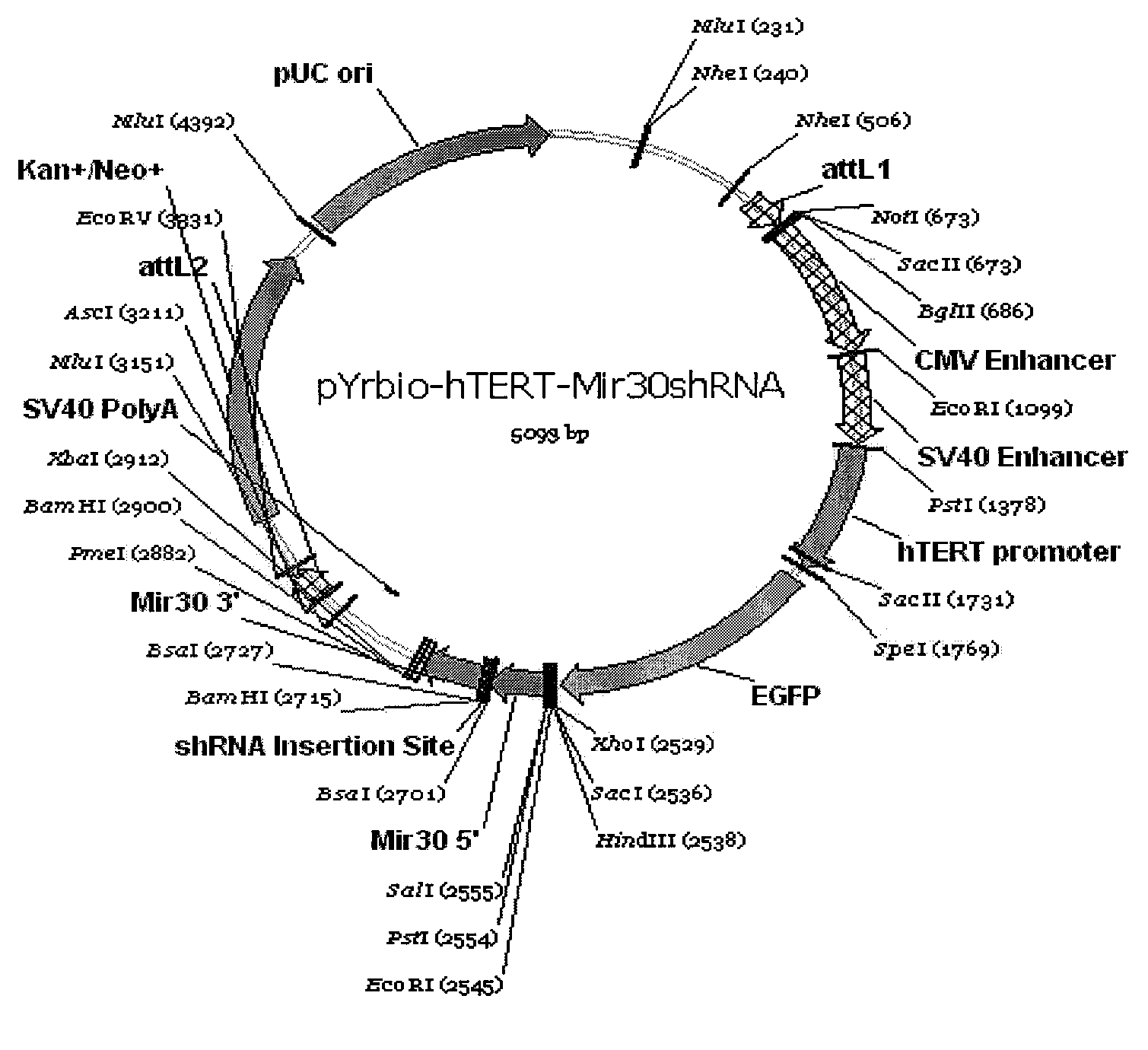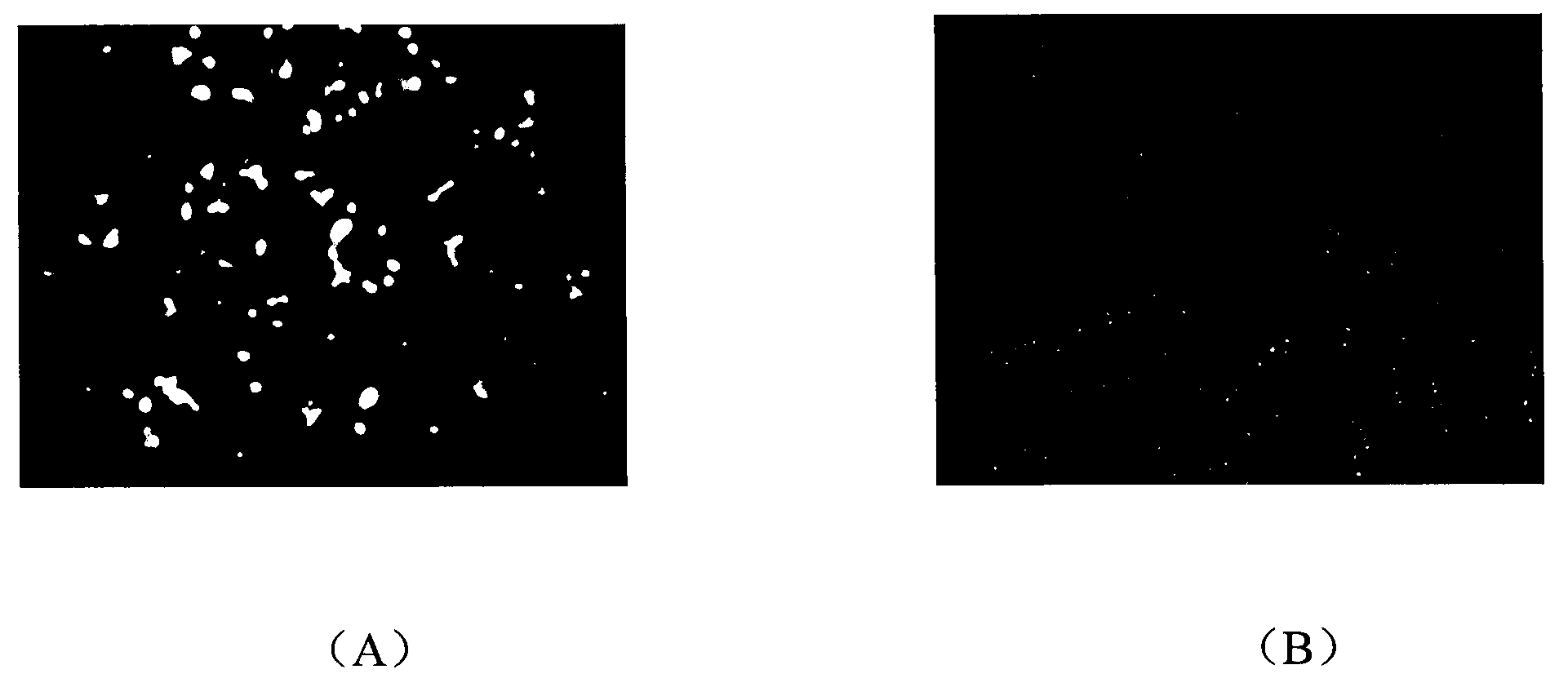Eukaryotic expression vector for expressing shRNA (short hairpin Ribonucleic Acid) in manner of targeting in cancer cells
A technology for eukaryotic expression vectors and tumor cells, applied in the field of eukaryotic expression vectors, can solve problems such as reducing siRNA production, shRNA expression and shearing effects, and achieve the effects of increasing production, solving non-specific interference problems, and increasing expression.
- Summary
- Abstract
- Description
- Claims
- Application Information
AI Technical Summary
Problems solved by technology
Method used
Image
Examples
Embodiment 1
[0033]Construction of vector pYrbio-hTERT-Mir30shRNA targeting expression of shRNA in tumor cells
[0034] Methods: Using the commercial vector pYrbio-Mir30-shRNA (produced by Changsha Yingrun Biotechnology Co., Ltd., as shown in SEQID2) as the backbone, through a series of transformations, the vector pYrbio-hTERT- Mir30shRNA.
[0035] (1) Synthesize hTERT promoter (about 385bp), and load it on pMD19-T Simple Vector. In the upstream of hTERT promoter fragment, add BglII, EcoRI, PstI restriction site; in the downstream of hTERT promoter fragment, add SpeI restriction site. The constructed vector was named TS-hTERTp.
[0036] (2) PCR amplify the SV40 Enhancer fragment from pCDNA3.1(+), add EcoRI and PstI restriction sites at both ends. Using EcoRI and PstI as subcloning sites, the SV40 Enhancer fragment was subcloned into TS-hTERTp. The constructed vector was named TS-SV40E-hTERTp.
[0037] (3) PCR amplify the CMV Enhancer fragment from pCDNA3.1(+), and add BglII and EcoRI ...
Embodiment 2
[0043] Specific Interfering with the Expression of CD146 Gene in Hepatocellular Carcinoma Cells
[0044] Methods: The shRNA targeting human CD146 gene was inserted into the shRNA Insertion Site of the pYrbio-hTERT-Mir30shRNA vector to construct the pYrbio-hTERT-Mir30-CD146 vector.
[0045] The pYrbio-hTERT-Mir30-CD146 vector was transfected into the liver cancer cell line HepG2, the cells were collected 48 hours later, RNA and protein were extracted, and the target gene CD146 was detected by RT-PCR and Western-blot. HepG2 cells not transfected with any plasmid served as the control group.
[0046] Results: After the constructed shRNA expression vector pYrbio-hTERT-Mir30-CD146 was transfected into HepG2 cells, obvious green fluorescence could be observed under the fluorescence microscope 24 hours later, indicating that the entire plasmid expression cassette was working normally, and the expression level of shRNA was relatively low. high. However, no green fluorescence was see...
Embodiment 3
[0050] Study on the specificity of hTERT promoter
[0051] Methods: The pYrbio-hTERT-Mir30shRNA vector was transfected into liver cancer cell line HepG2 and human normal fibroblast cell line HELF, respectively, and the fluorescence was observed under a fluorescence microscope 24 hours later.
[0052] Results: After the pYrbio-hTERT-Mir30shRNA vector was transfected into the liver cancer cell line HepG2 cells, obvious green fluorescence could be observed under the fluorescence microscope 24 hours later, indicating that the entire plasmid expression cassette was working normally. However, after pYrbio-hTERT-Mir30shRNA was transfected into human normal fibroblast cell line HELF, no green fluorescence was seen. The fluorescence observation photos of HepG2 cells and HELF cells are shown in Figure 4 .
[0053] Conclusion: The pYrbio-hTERT-Mir30shRNA vector constructed by the method provided by the present invention, its hTERTpromoter-EGFP-Mir30shRNA-SV40 PolyA expression cassette...
PUM
 Login to View More
Login to View More Abstract
Description
Claims
Application Information
 Login to View More
Login to View More - R&D
- Intellectual Property
- Life Sciences
- Materials
- Tech Scout
- Unparalleled Data Quality
- Higher Quality Content
- 60% Fewer Hallucinations
Browse by: Latest US Patents, China's latest patents, Technical Efficacy Thesaurus, Application Domain, Technology Topic, Popular Technical Reports.
© 2025 PatSnap. All rights reserved.Legal|Privacy policy|Modern Slavery Act Transparency Statement|Sitemap|About US| Contact US: help@patsnap.com



